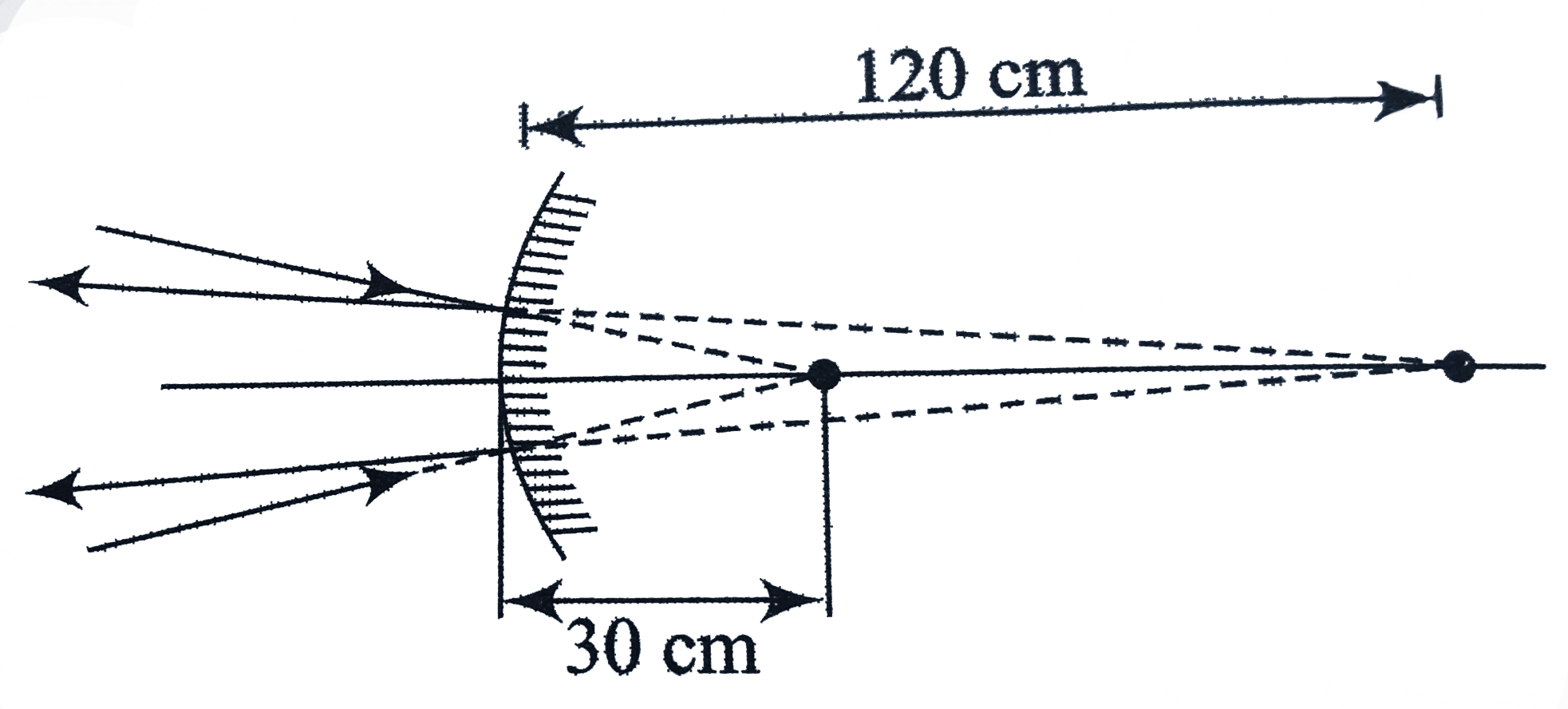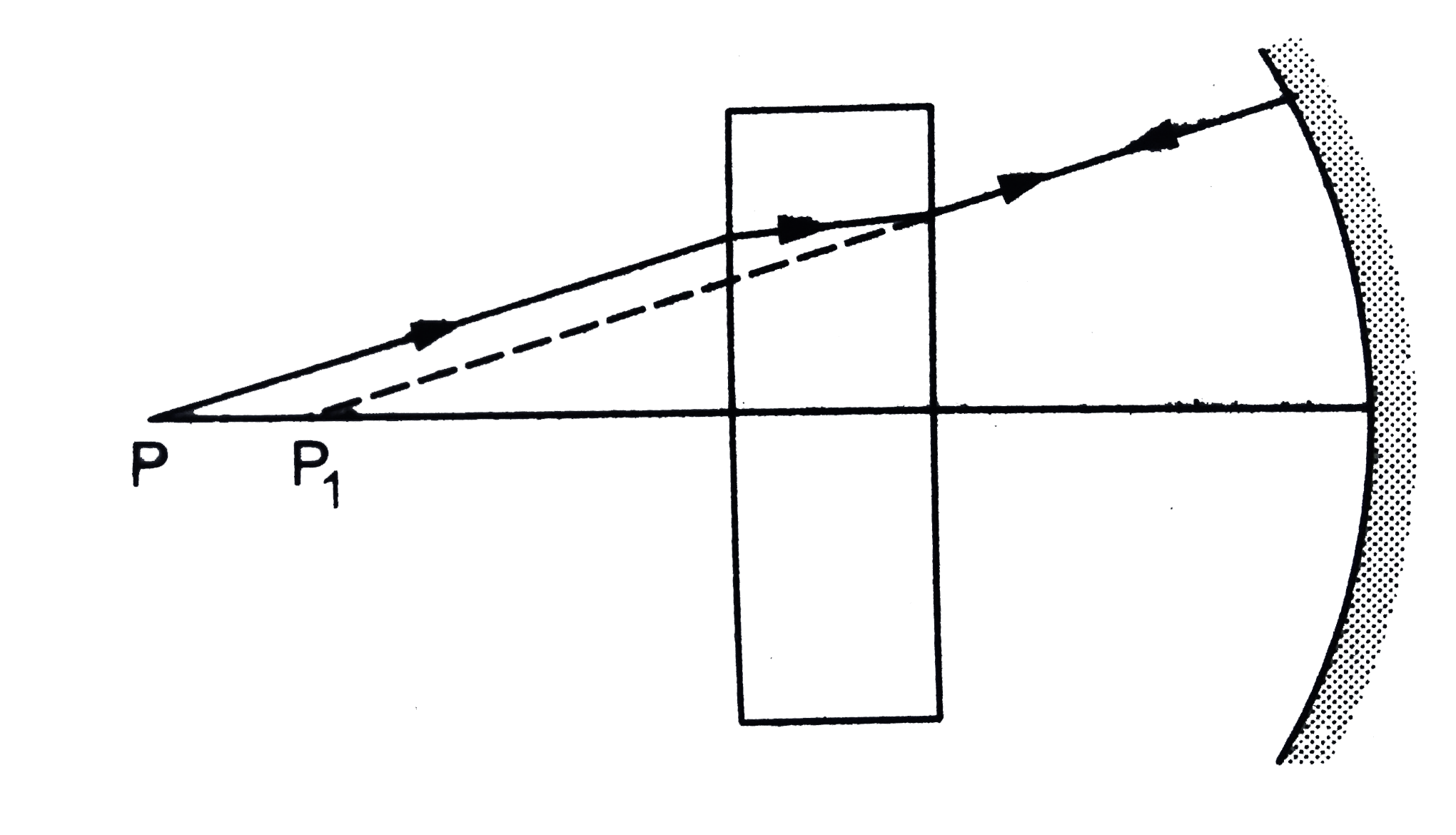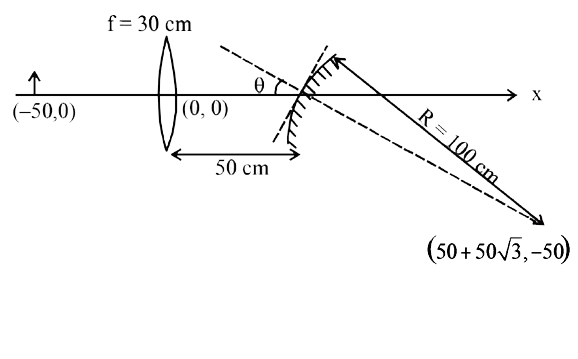Two rays are incident on a spherical mirror of radius R = 5 cm parallel to its optical axis at distances h1=0.5cm and h2=3cm Determine the distance Δx between the points at which these rays intersect the optical axis after being reflected at the mirror.
The correct Answer is:5/8=0.625cm
To solve the problem of finding the distance Δx between the points at which two rays intersect the optical axis after being reflected by a spherical mirror, we can follow these steps:
Step 1: Understand the Geometry of the Problem
We have a spherical mirror with a radius R=5cm. Two rays are incident parallel to the optical axis at heights h1=0.5cm and h2=3cm from the optical axis.
Step 2: Identify the Angles of Incidence
For each ray, we can find the angles of incidence α and β using the sine function:
- For the first ray (height h1):
sinα=h1R=0.55=0.1⟹α=arcsin(0.1)≈5.74∘
- For the second ray (height h2):
sinβ=h2R=35=0.6⟹β=arcsin(0.6)≈36.87∘
Step 3: Calculate the Distances from the Mirror to the Optical Axis
Using the cosine of the angles, we can find the distances x1 and x2 where the rays intersect the optical axis after reflection.
- For the first ray:
x1=Rcosα−h1tanα
Where tanα=h1Rcosα.
- For the second ray:
x2=Rcosβ−h2tanβ
Where tanβ=h2Rcosβ.
Step 4: Substitute the Values
Now we substitute the values of R, h1, and h2 into the equations for x1 and x2.
1. Calculate x1:
x1=5cos(5.74∘)−0.5tan(5.74∘)
2. Calculate x2:
x2=5cos(36.87∘)−3tan(36.87∘)
Step 5: Calculate Δx
Finally, we find Δx as follows:
Δx=x2−x1
Step 6: Solve for Δx
After calculating x1 and x2, we can find the numerical value of Δx.
Final Calculation
After performing the calculations, we find:
Δx≈0.62cm
Conclusion
Thus, the distance Δx between the points at which the two rays intersect the optical axis after being reflected at the mirror is approximately 0.62cm.
---
We have a spherical mirror with a radius R=5cm. Two rays are incident parallel to the optical axis at heights h1=0.5cm and h2=3cm from the optical axis.
For each ray, we can find the angles of incidence α and β using the sine function:
- For the first ray (height h1):
sinα=h1R=0.55=0.1⟹α=arcsin(0.1)≈5.74∘
- For the second ray (height h2):
sinβ=h2R=35=0.6⟹β=arcsin(0.6)≈36.87∘
Using the cosine of the angles, we can find the distances x1 and x2 where the rays intersect the optical axis after reflection.
x1=Rcosα−h1tanα
Where tanα=h1Rcosα.
x2=Rcosβ−h2tanβ
Where tanβ=h2Rcosβ.
Now we substitute the values of R, h1, and h2 into the equations for x1 and x2.
x1=5cos(5.74∘)−0.5tan(5.74∘)
x2=5cos(36.87∘)−3tan(36.87∘)
Finally, we find Δx as follows:
Δx=x2−x1
After calculating x1 and x2, we can find the numerical value of Δx.
After performing the calculations, we find:
Δx≈0.62cm
Thus, the distance Δx between the points at which the two rays intersect the optical axis after being reflected at the mirror is approximately 0.62cm.
Topper's Solved these Questions
- DAILY PRACTICE PROBLEMBOOK - RESONANCE ENGLISHCHAPTER - DAILY PRACTICE PROBLEMEXERCISE - DPP No.15
20 Videos
- DAILY PRACTICE PROBLEMBOOK - RESONANCE ENGLISHCHAPTER - DAILY PRACTICE PROBLEMEXERCISE - DPP No.16
9 Videos
- DAILY PRACTICE PROBLEMBOOK - RESONANCE ENGLISHCHAPTER - DAILY PRACTICE PROBLEMEXERCISE - DPP No.13
20 Videos
- CURRENT ELECTRICITYBOOK - RESONANCE ENGLISHCHAPTER - CURRENT ELECTRICITYEXERCISE - High Level Problems (HIP)
19 Videos
- ELECTRO MAGNETIC WAVESBOOK - RESONANCE ENGLISHCHAPTER - ELECTRO MAGNETIC WAVESEXERCISE - Exercise 3
27 Videos
Similar Questions
A converging beam of light rays in incident on a concave spherical mirror whose radius of curvature is 0.8m. Determine the position of the point on the optical axis of the mirror where the reflected rays intersect, if the extensions of the incident rays intersect the optical axis 40cm form the mirror's pole.
View SolutionConverging rays are incident ono a convex spherical mirror so that their extensions intersect 30cm behind the mirror on the optical axis. The reflected rays form a diverging beam so that their extensions intersect the optical axis 1.2 m from the mirror. Determine the focal length of the mirror.

View SolutionA parallel beam of rays is incident on a consisting pf three thin lenses with a common optical axis. The focal length of the lenses are equal to f1=+10cmandf2=−20cm,andf3=+9cm respectively. The distance between the first and the second lens is 15cm and between the second and the third is 5cm. Find the position of the point at which the beam converges when it leaves the system of lenses.
View SolutionA converging lens and a diverging mirror are placed at a separation of 15 cm. The focal length of the lens is 25 cm and that of the mirror is 40 cm. Where should a point source be placed between the lens and the mirror so that the light, after getting reflected by the mirror and then getting transmitted by the lens, comes out parallel to the principal axis ?
View SolutionA converging lens and a diverging mirror are placed at a separation of 20 cm. The focal length of the lens is 30 cm and that of the mirror is 50 cm. Where should a point source be placed between the lens and the miror, so that the light, after getting reflected by the mirror and then getting transmitted by the lens, comes out parallel to the principal axis?
View SolutionWhat is the distance between two parallel tangents to a circle of radius 5 cm?
View SolutionA ray of light is incident on a concave mirror . It is parallel to the principal axis and its height from principal axis is equal to the focal length of the mirror. The ratio of the distance of point B to the distance of the focus from the centre of curvature is (AB is the reflected ray)
_E01_055_Q01.png)
View SolutionAn object is placed 21 cm in fron of a concave mirror of radius of curvature 20 cm.A glass slab of thicknes 3 cm and refractive index 1.5 is palced close to the mirror in the space between the object and the mirror. Find the position of the final image fromed. The distance of the nearer surface of the slab from the mirror is 10 cm.

View SolutionA small object is placed 50 cm to the left of a thin convex lens of focal length 30 cm. A convex spherical mirror of radius of curvature 100 cm is placed to the right of the lens at a distance of 50 cm. The mirror is tilted such that the axis of the mirror is at an angle θ=30degree to the axis of the lens, as shown in the figure
If the origin of the coordinate system is taken to be at the centre of the lens, the coordinates (in cm) of the point (x,y) at which the image is formed are

View SolutionConvex and concave mirrors have the same radii of curvature R. The distanc between the
mirrors is 2R. At what point on the common optical axis of the mirrors should a point source of
light A be placed for the rays to coverage at the point A after being reflected first on the convex
and then on the concave mirror?
View Solution
